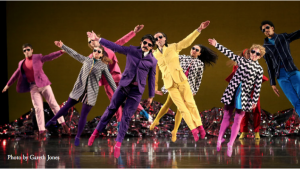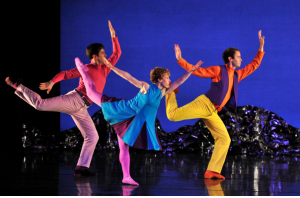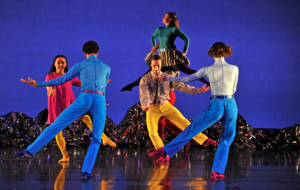Innocence Meets Irony in Mark Morris’s Idea-Rich “Pepperland”
“Pepperland,” the new piece that the Mark Morris Dance Group performed here on Saturday, is—and isn’t—set to “Sgt. Pepper’s Lonely Hearts Club Band.” The company’s music ensemble uses songs from the 1967 album, but this is no Beatles cover band. Morris and composer Ethan Iverson reimagined those cheeky, impossibly youthful tunes with discordant undertones and sometimes-anarchic rhythms, in a brilliant mix of kid-like fun and something darker, innocence and irony.
 La Jolla Music Society presented the program at the Civic Theatre, a cavernous venue that can overwhelm dance. That was no problem here. “Pepperland” exploded into the space with 15 superb dancers, dressed (by Elizabeth Kurtzman) in the Day-Glo tones of the album cover, and a seven-person music ensemble of voice, horns, piano, percussion, harpsichord, and theremin.
La Jolla Music Society presented the program at the Civic Theatre, a cavernous venue that can overwhelm dance. That was no problem here. “Pepperland” exploded into the space with 15 superb dancers, dressed (by Elizabeth Kurtzman) in the Day-Glo tones of the album cover, and a seven-person music ensemble of voice, horns, piano, percussion, harpsichord, and theremin.

Photo: Robbie Jack
With the exuberance of flower children, the dancers sometime cavort like puppies, doing off-balance jumps, hip swivels, wide-armed wheeling turns, and leg flicks like very precise sailors dancing a hornpipe
They form hand-holding lines, a folk dance touch that’s a Morris signature, as well as a symbol of the love and peace spirit of the 1960s. But things go awry. The end person breaks from the line into their own moves. Vertical lines of dancers advance with slow stagger-steps as if dragging chains.
In “When I’m Sixty-Four,” dancers link arms for a unison combination, but can they keep up as the music fractures into clashing rhythms, sounding like a honkytonk player piano that’s slipped offtrack? (Iverson combined bars of four, five, and six counts.) These magnificent dancers make it work, but they’re reeling.
Iverson also composed five original pieces, woven through the score, playing with classical musical forms. In “Adagio,” a series of three couples—two women, a man and a woman, then two men—do balletic partnering (sometimes intentionally awkward ballet, like a goofy lift where the liftee splays their legs) to romantic piano and an unearthly wail that a musician-friend figured was voice played through the theremin.

Photo: Robbie Jack
So much happens! Morris throws in the Charleston, gogo dancing, a man in “Within You Without You” striking poses like dancers in Indian art. In the midst of whatever else is happening, women are paraded in joyful lifts across the stage.
Sparkly detritus heaped behind them (Johan Henckens’s set design) become fairy lights or garbage, depending on Nick Kolin’s lighting.
George Balanchine was noted for choreographing more steps than anyone else. “Pepperland” overflows not only with movement invention but with ideas. In a fascinating coincidence, La Jolla Music Society presented two dances this season by noted choreographers using music from the 1960s. The two couldn’t have been more different. Paul Taylor’s vapid “Changes,” shown here in January, used music by the Mamas and Papas (seriously?) and reduced the 60s to hippie chicks and bell-bottoms. “Pepperland,” in happy contrast, is a work of substance, a celebration of the youthful creativity and idealism of the 1960s … and a complex, important reflection on what became of those dreams.

Award-winning dance journalist Janice Steinberg has published more than 400 articles in the San Diego Union-Tribune, Dance Magazine, the Los Angeles Times, and elsewhere. She was a 2004 New York Times-National Endowment for the Arts fellow at the Institute for Dance Criticism and has taught dance criticism at San Diego State University. She is also a novelist, author of The Tin Horse (Random House, 2013). For why she’s passionate about dance, see this article on her web site, The Tin Horse
